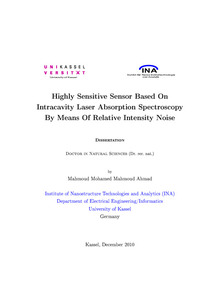| dc.date.accessioned | 2011-01-07T11:04:50Z | |
| dc.date.available | 2011-01-07T11:04:50Z | |
| dc.date.issued | 2011-01-07T11:04:50Z | |
| dc.identifier.uri | urn:nbn:de:hebis:34-2011010735299 | |
| dc.identifier.uri | http://hdl.handle.net/123456789/2011010735299 | |
| dc.language.iso | eng | |
| dc.rights | Urheberrechtlich geschützt | |
| dc.rights.uri | https://rightsstatements.org/page/InC/1.0/ | |
| dc.subject | Intracavity Laser Absorption Spectroscopy (ICLAS) | eng |
| dc.subject | Relative Intensity Noise (RIN) | eng |
| dc.subject | External Cavity Diode Laser (ECDL) | eng |
| dc.subject | Mode Competition | eng |
| dc.subject | Medical Sensor | eng |
| dc.subject | Propofol | eng |
| dc.subject.ddc | 000 | |
| dc.subject.ddc | 500 | |
| dc.subject.ddc | 530 | |
| dc.subject.ddc | 540 | |
| dc.subject.ddc | 600 | |
| dc.subject.ddc | 610 | |
| dc.subject.ddc | 620 | |
| dc.subject.ddc | 660 | |
| dc.title | Highly Sensitive Sensor Based On Intracavity Laser Absorption Spectroscopy By Means of Relative Intensity Noise | eng |
| dc.type | Dissertation | |
| dcterms.abstract | This thesis concerns with the main aspects of medical trace molecules detection by means of intracavity laser absorption spectroscopy (ICLAS), namely with the equirements for highly sensitive, highly selective, low price, and compact size sensor. A novel two modes semiconductor laser sensor is demonstrated. Its operation principle is based on the competition between these two modes. The sensor sensitivity is improved when the sample is placed inside the two modes laser cavity, and the competition between the two modes exists. The effects of the mode competition in ICLAS are discussed theoretically and experimentally. The sensor selectivity is enhanced using external cavity diode laser (ECDL) configuration, where the tuning range only depends on the external cavity configuration. In order to considerably reduce the sensor cost, relative intensity noise (RIN) is chosen for monitoring the intensity ratio of the two modes. RIN is found to be an excellent indicator for the two modes intensity ratio variations which strongly supports the sensor methodology. On the other hand, it has been found that, wavelength tuning has no effect on the RIN spectrum which is very beneficial for the proposed detection principle.
In order to use the sensor for medical applications, the absorption line of an anesthetic sample, propofol, is measured. Propofol has been dissolved in various solvents. RIN has been chosen to monitor the sensor response. From the measured spectra, the sensor sensitivity enhancement factor is found to be of the order of 10^(3) times of the conventional laser spectroscopy. | eng |
| dcterms.accessRights | open access | |
| dcterms.alternative | Hoch empfindlicher Sensor Auf Basis der Intracavity Laser Absorption Spectroscopy mit Hilfe von Relative Intensity Noise | ger |
| dcterms.creator | Ahmad, Mahmoud Mohamed Mahmoud | |
| dc.contributor.corporatename | Kassel, Universität, FB 16, Elektrotechnik/Informatik | |
| dc.contributor.referee | Hillmer, Hartmut (Prof. Dr.) | |
| dc.contributor.referee | Witzigmann, Bernd (Prof. Dr.) | |
| dc.subject.swd | Laserspektroskopie | ger |
| dc.subject.swd | Sensor | ger |
| dc.date.examination | 2010-12-20 | |

